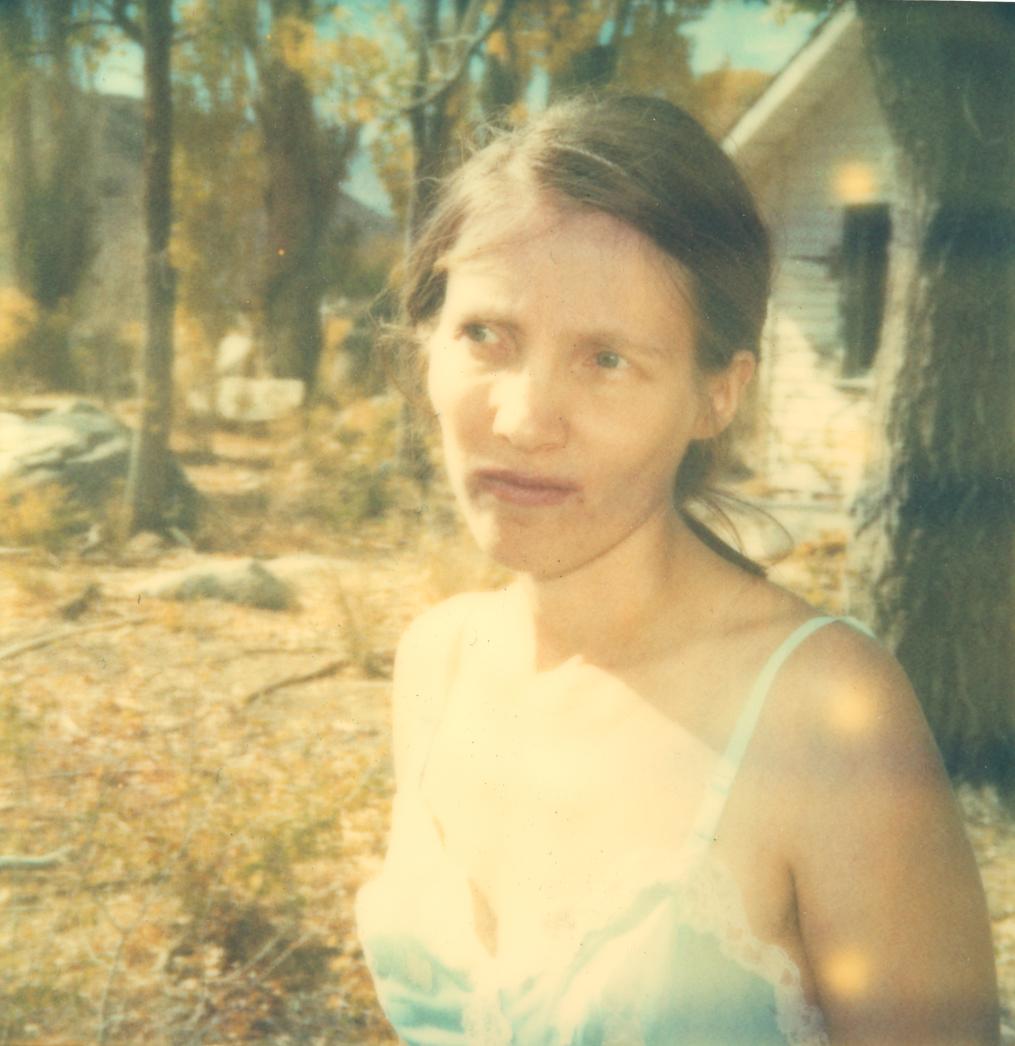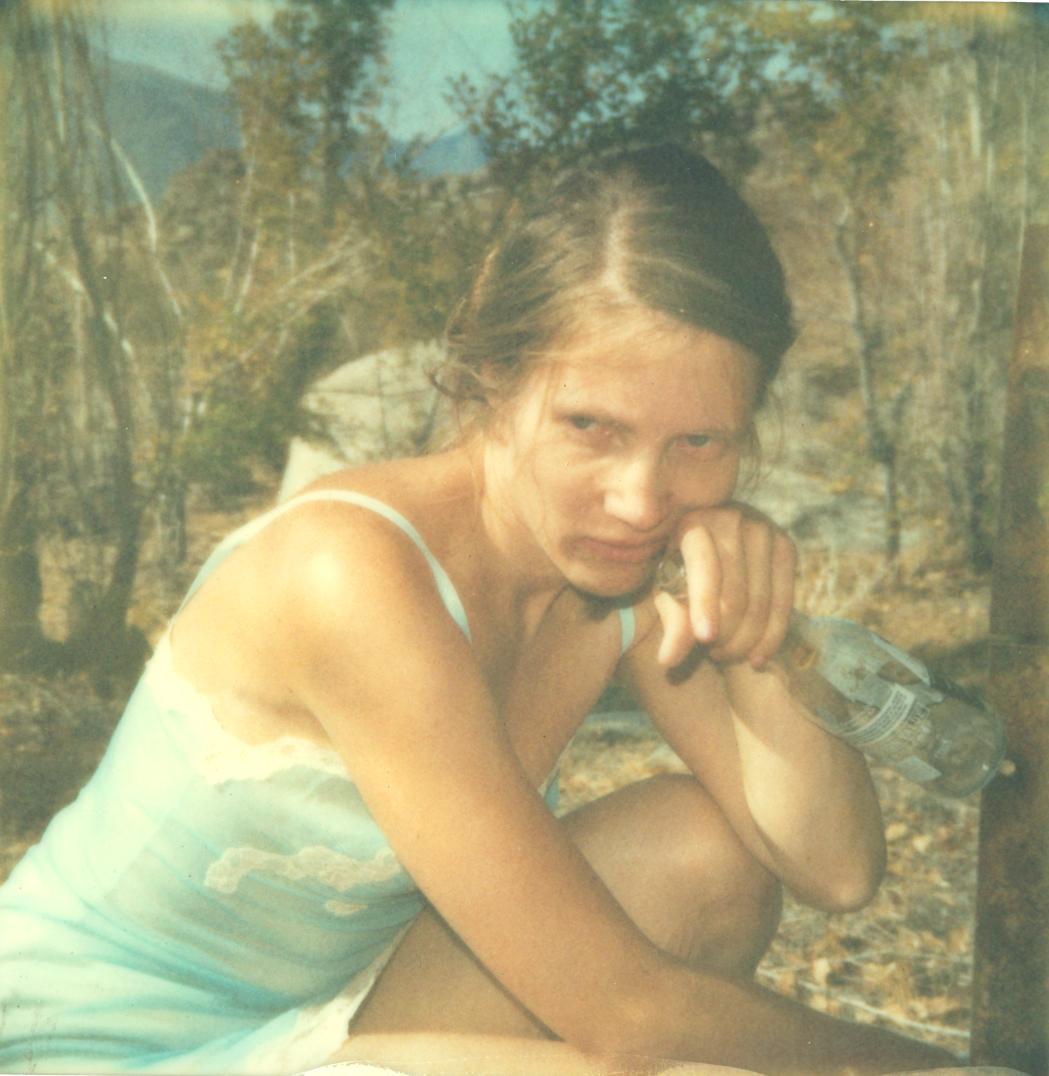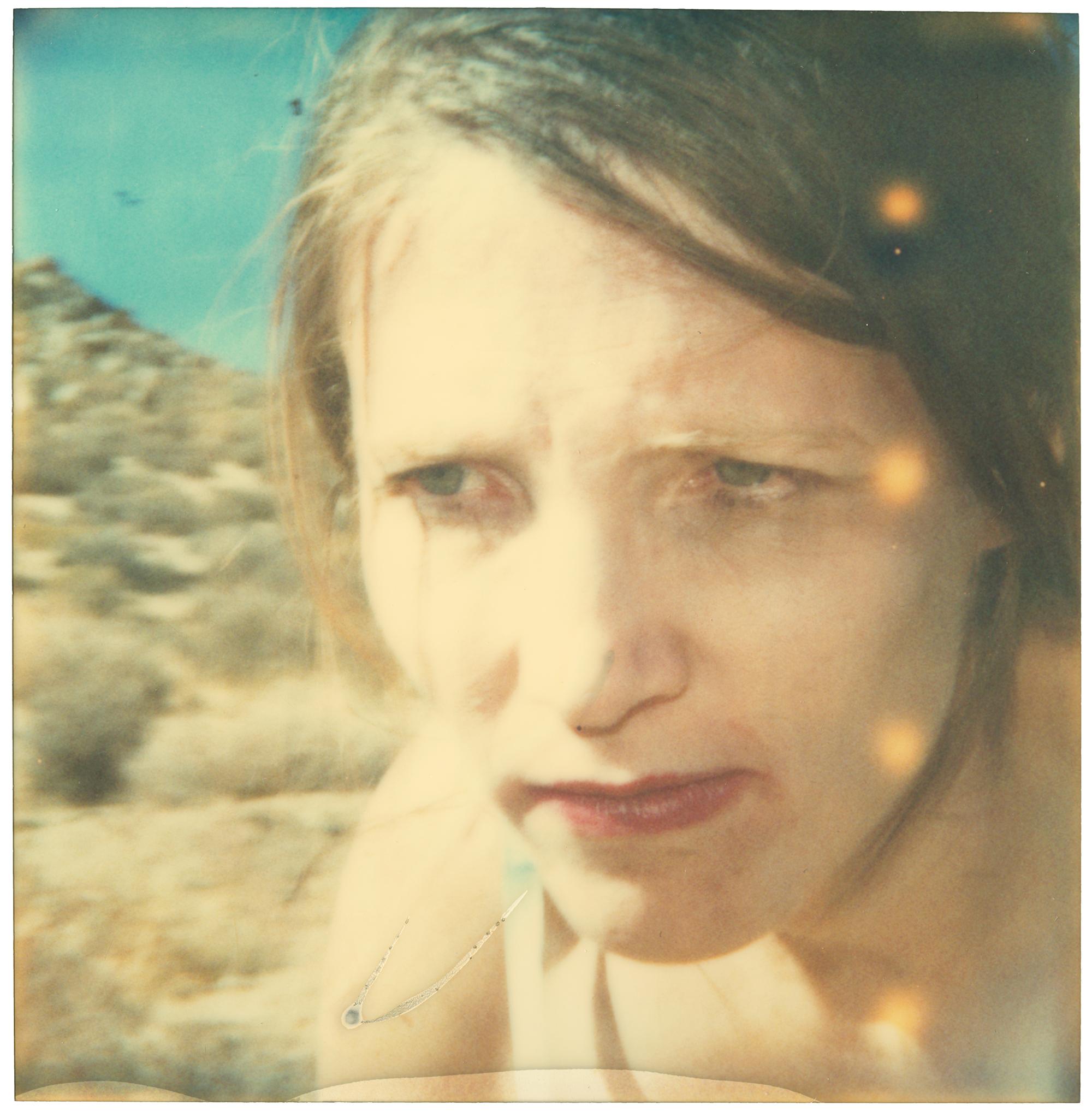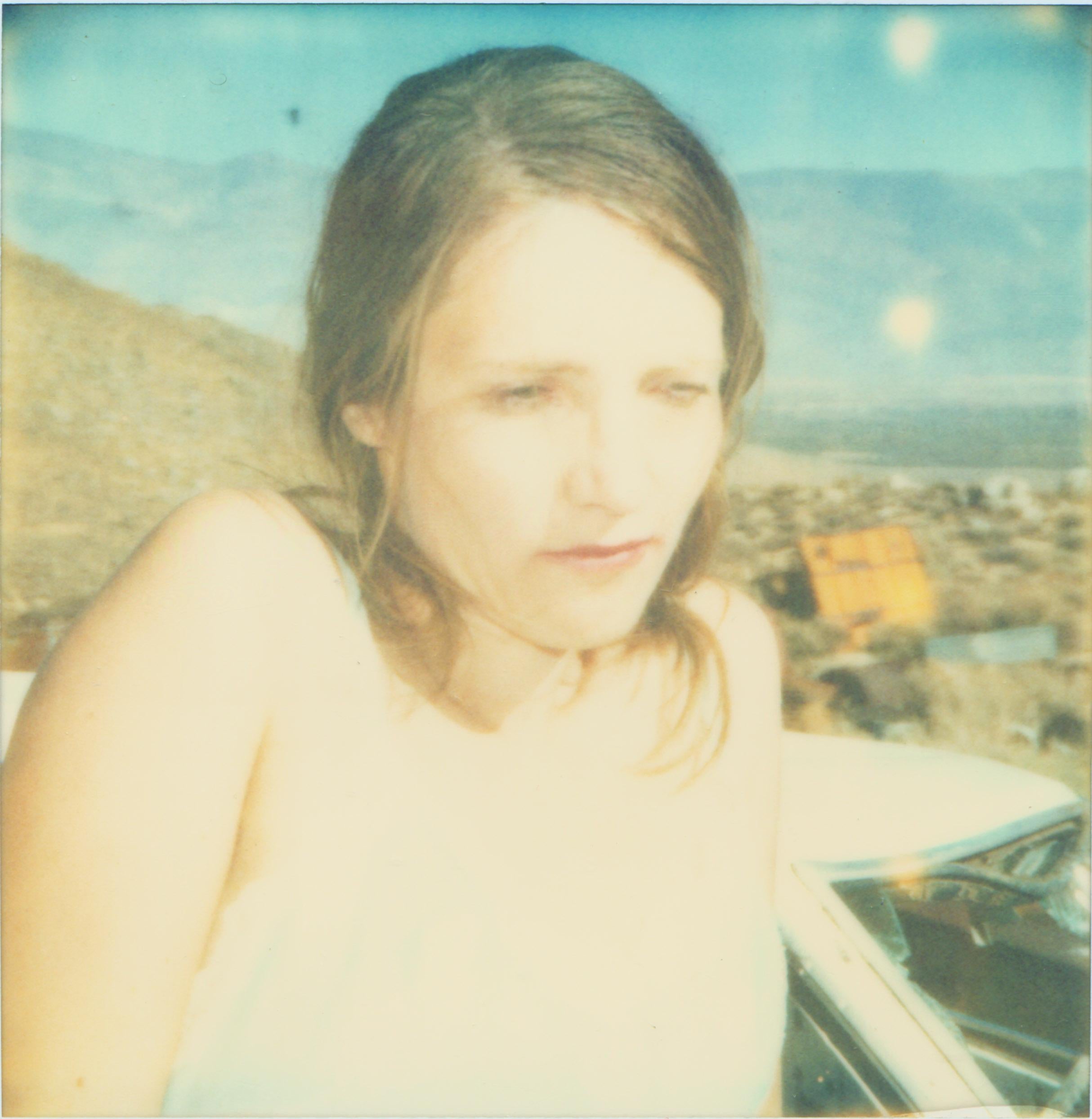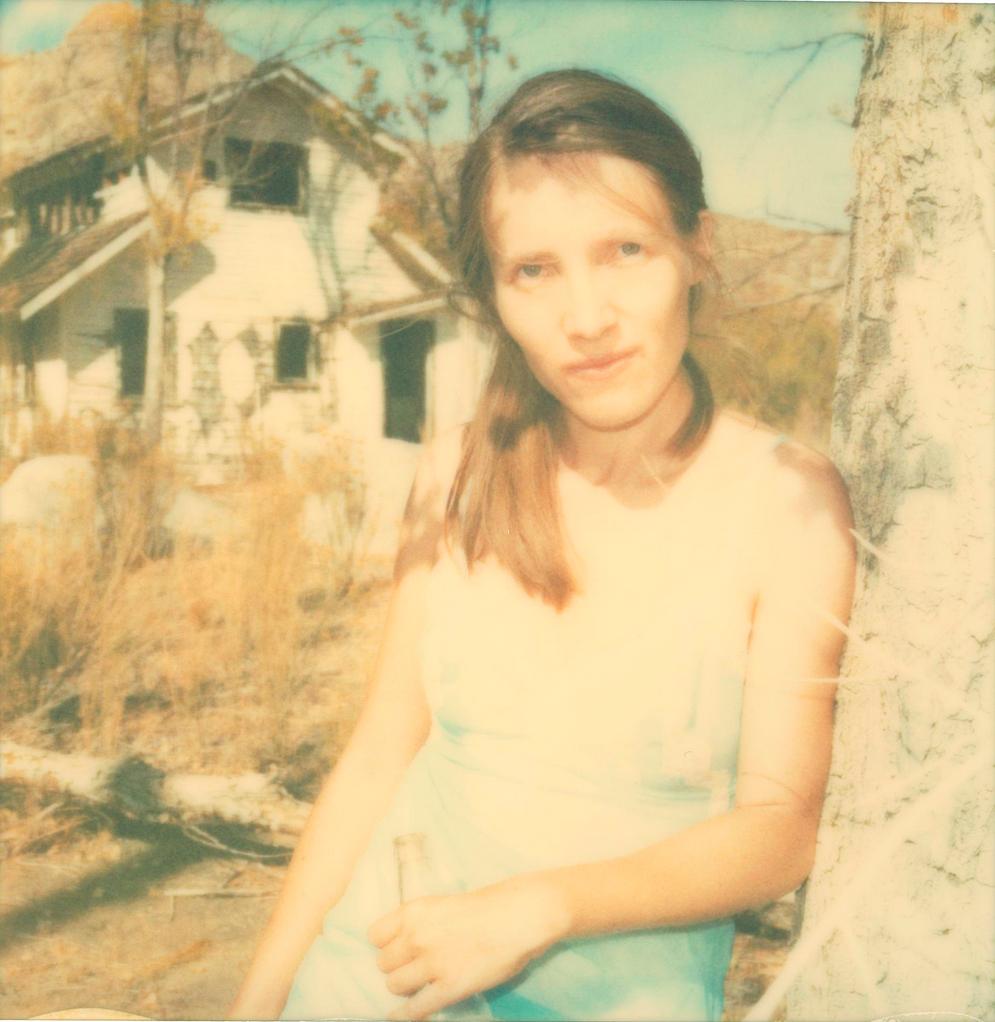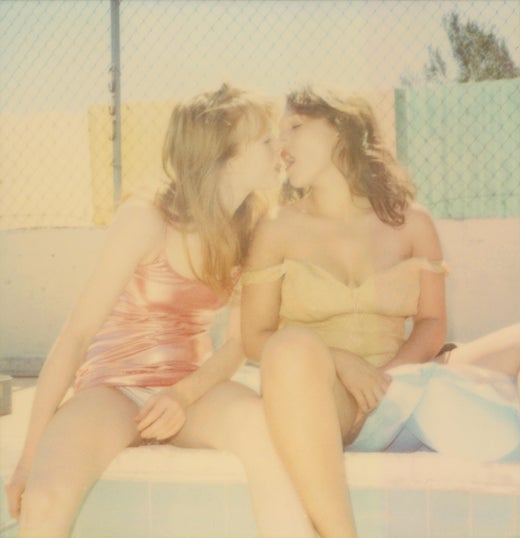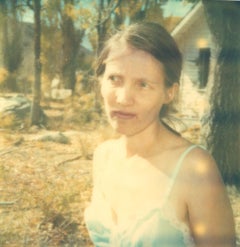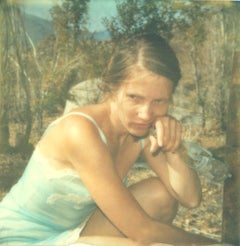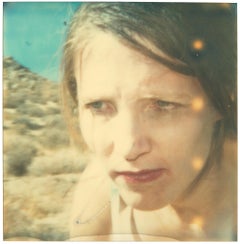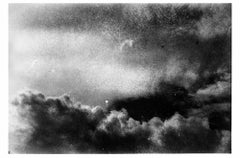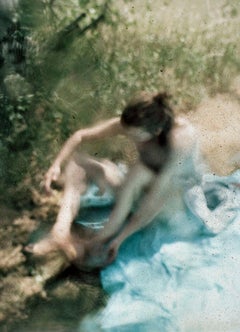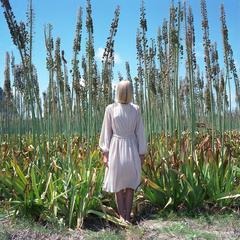Items Similar to It's Going to Be OK (Wastelands) - Contemporary, Analog, Polaroid, Color
Want more images or videos?
Request additional images or videos from the seller
1 of 2
Stefanie SchneiderIt's Going to Be OK (Wastelands) - Contemporary, Analog, Polaroid, Color2003
2003
$380
£287.60
€330.08
CA$541.34
A$587.10
CHF 308.37
MX$7,131.30
NOK 3,858.71
SEK 3,633.19
DKK 2,465.35
About the Item
It's Going to Be OK (Wastelands) - 2003
20x20cm,
Edition of 10 plus 2 Artist Proofs.
Archival C-Print, based on the original Polaroid.
Artist inventory Number 23890.
Signature label and Certificate.
Not mounted.
For sale is a piece from the Wastelands series.
Reality with the Tequila:
Stefanie Schneider’s Fertile Wasteland
by James Scarborough
“How much more than enough
for you for I for both of us darling?”
(E. E. Cummings)
Until he met her, his destiny was his own. Petty and inconsequential but still his own. He was cocksure and free, young and unaccountable, with dark hair and aquiline features. His expression was always pensive, a little troubled, but not of a maniacal sort. He was more bored than anything else. With a heart capable of violence.
Until she met him, she was pretty but unappreciated. Her soul had registered no seismic activity. Dustbowl weary, she’d yet to see better days. A languorous body, a sweet face with eyes that could be kind if so inclined.
Until she met him, she had not been inclined.
It began when he met her. She was struck in an instant by his ennui. The sum of their meeting was greater than the imbroglios and chicaneries of their respective existences. He was struck by the blank slate look in her eyes. They walked, detached and focused on the immediate, obscenely unaware of pending change across a terrain of mountainous desert, their eyes downcast and world-weary, unable to account for the buoyant feeling in her heart. His hard-guy shtick went from potentiality to ruse. The gun was not a weapon but a prop, a way to pass time. Neither saw the dark clouds massing on the horizon.
They found themselves alone in the expanses of time, unaware of the calamity that percolated even as they posed like school kids for the pictures. Happiness brimmed in that wild terrain. Maybe things were beginning to look up.
That’s when the shooting started…
Stefanie Schneider assumes that our experience of lived reality (buying groceries, having a relationship with someone, driving a car) does not correspond to the actual nature of lived reality itself, that what we think of as reality is more like a margarita without the tequila.
Stefanie Schneider’s reality is reality with the tequila. She does not abolish concepts that orient us, cause and effect, time, plot, and storyline, she just plays with them. She invites us to play with them, too. She offers us a hybrid reality, more amorphous than that with a conventional subject, verb, and predicate. Open-ended, this hybrid reality does not resolve itself. It frustrates anyone with pedestrian expectations but once we inebriate those expectations away, her work exhilarates us and even the hangover is good. An exploration of how she undermines our expectation of what we assume to be our lived reality, the reasons why she under- mines our expectations, and the end result, as posited in this book, will show how she bursts open our apparatus of perception and acknowledges life’s fluidity, its density, its complexity. Its beauty.
She undermines expectations of our experience of reality with odd, other-worldly images and with startling and unexpected compressions and expansions of time and narrative sequence. The landscape seems familiar enough, scenes from the Old West: broad panoramic vistas with rolling hills dotted with trees and chaparral, dusty prairies with trees and shrubs and craggy rocks, close-up shots of trees. But they’re not familiar. These mis-en-scenes radiate an unsettling Picasso Blue Period glow or the intense celestial blue of the cafe skies that Van Gogh painted in the south of France. Yellow starbursts punctuate images as if seen through the viewfinder of a flying saucer. At the same time, objects appear both vintage and futuristic, the landscape of a post-apocalyptic world.
Landscapes change seemingly at random as do the seasons. Stefanie Schneider offers no indication of how time flows here, except that it conceivably turns in on itself and then goes its merry way. Time is a river whose source is a deep murky spring which blusters about with an occasional swirling eddy.
That Stefanie Schneider thwarts an easy reading is obvious but why does she do this? Since she will not countenance anything linear, logical, or sequential, and because she does not relish anything concrete and specific, she has to roil things up a bit. Nor does she seem comfortable with a book of images that is settled, discrete, and accountable. Instead she wants to create a panoply of anxious moments that refuse to settle down into any predetermined reading. She seeks to assemble the elements, establish a provisional cosmology and then let each of us bring our own life experiences to bear on the enterprise. She unravels the paucity of a universe compromised by a matrix of either/or and replaces it with a kaleidoscopic neither/both cornucopia.
No fan of Descartes, she does not adhere to anything predicated on cogito ergo sum. No, the chance to present a universe of limitless iterations and utterances, open-ended, casualty-thwarting, intrigues her. She broaches a Heraclitan world: she shows that attempts to master, manage, and hoard time prove to be as elusive as a blind man trying to grab a salmon barehanded from a cold mountain stream. Even within the clear-cut parameters of the Old West universe onto which she gloms, she shows that time is a bandit, that it is a mirage, that it is as unpredictable as it is indefinable and infinite. She coaxes us, scene by scene a slow-motion, out-ofsequence film clip, to agree with her that a running moat of lived reality easily overwhelms a castle of rationality.
Stefanie Schneider does not mount a demolition effort much less a deconstruction one. Rather, she dismantles our expectations and sets about rebuilding not things but their connections anew. She is the mistress of the synapses. Indeed all these annoying ambiguities and irritating am- biances set the stage for a very particular certainty, one kernel of truth amidst these skewed and open-ended fields of inquiry. What connects all these images, in whatever order they might be presented1, is what I call an Augenblick, the mental distance between each page in whose ex- panse occurs the processing of shards of lived experience between these blinks of an eye that comprise the pages of Wastelands. During these innumerous Augenblicke, we take whatever shifts and turns that Stefanie Schneider throws at us, recalibrate our bearings, and then move on, at least until the next inevitable obstruction.
Irritating (and enlightening) as these shots may be, they’re nothing new. Rilke writes that, instead of trying to understand the quiddities of things, we should just be joyous at their mystery, just assume that they’re written in a lovely script that neither you nor anyone else can ever understand. Keats writes about being “awake forever in a sweet unrest,” although he’s talking about love. Stefanie Schneider makes us work for this idea of an Augenblick, but the result is worth it. The scenes and their sequencing dazzle us in a Borgesian Hall of Mirrors. Stefanie Schneider shows us that reality is anything but linear and user-friendly, but once one becomes accustomed to her enhanced dimension of space and time, we see the world in all its multifarious beauty and rapture. For that reason, Stefanie Schneider’s Augenblicke show us that reality may be a wasteland but it is as fertile as fertile can be.
1 I refer to Julio Cortazar’s novel, Hopscotch, in which he presents his story in a linear
way, with consecutive chapters that follow a particular coherence. In a note at the be-
ginning of the novel, he suggests an alternative reading via a new sequence of chapters.
So instead of reading chapter 1 first, chapter 2 second, you read, say chapter 57 first,
chapter 32 second, chapter 1 third and so on to form a new story. Similarly, Stefanie
Schneider’s Wastelands offers a multitude of coherences.
- Creator:Stefanie Schneider (1968, German)
- Creation Year:2003
- Dimensions:Height: 7.88 in (20 cm)Width: 7.88 in (20 cm)Depth: 0.04 in (1 mm)
- Medium:
- Movement & Style:
- Period:
- Condition:
- Gallery Location:Morongo Valley, CA
- Reference Number:1stDibs: LU652314609212
Stefanie Schneider
Stefanie Schneider received her MFA in Communication Design at the Folkwang Schule Essen, Germany. Her work has been shown at the Museum for Photography, Braunschweig, Museum für Kommunikation, Berlin, the Institut für Neue Medien, Frankfurt, the Nassauischer Kunstverein, Wiesbaden, Kunstverein Bielefeld, Museum für Moderne Kunst Passau, Les Rencontres d'Arles, Foto -Triennale Esslingen., Bombay Beach Biennale 2018, 2019.
About the Seller
4.9
Platinum Seller
Premium sellers with a 4.7+ rating and 24-hour response times
Established in 1996
1stDibs seller since 2017
1,042 sales on 1stDibs
Typical response time: 1 hour
- ShippingRetrieving quote...Shipping from: Morongo Valley, CA
- Return Policy
Authenticity Guarantee
In the unlikely event there’s an issue with an item’s authenticity, contact us within 1 year for a full refund. DetailsMoney-Back Guarantee
If your item is not as described, is damaged in transit, or does not arrive, contact us within 7 days for a full refund. Details24-Hour Cancellation
You have a 24-hour grace period in which to reconsider your purchase, with no questions asked.Vetted Professional Sellers
Our world-class sellers must adhere to strict standards for service and quality, maintaining the integrity of our listings.Price-Match Guarantee
If you find that a seller listed the same item for a lower price elsewhere, we’ll match it.Trusted Global Delivery
Our best-in-class carrier network provides specialized shipping options worldwide, including custom delivery.More From This Seller
View AllAfter (Wastelands) - Contemporary, Analog, Polaroid, Color
By Stefanie Schneider
Located in Morongo Valley, CA
After (Wastelands) - 2003
20x20cm,
Edition of 10 plus 2 Artist Proofs.
Archival C-Print, based on the original Polaroid.
Artist inventory Number 18799.
Signature label and Certi...
Category
Early 2000s Contemporary Color Photography
Materials
Archival Paper, Photographic Paper, C Print, Color, Polaroid
Without You (Wastelands) - Contemporary, Analog, Polaroid, Color
By Stefanie Schneider
Located in Morongo Valley, CA
Without You (Wastelands) - 2003
20x20cm,
Edition of 10 plus 2 Artist Proofs.
Archival C-Print, based on the original Polaroid.
Artist inventory Number 934.
Signature label and Certificate.
Not mounted.
For sale is a piece from the Wastelands series.
Reality with the Tequila:
Stefanie Schneider’s Fertile Wasteland
by James Scarborough
“How much more than enough
for you for I for both of us darling?”
(E. E. Cummings)
Until he met her, his destiny was his own. Petty and inconsequential but still his own. He was cocksure and free, young and unaccountable, with dark hair and aquiline features. His expression was always pensive, a little troubled, but not of a maniacal sort. He was more bored than anything else. With a heart capable of violence.
Until she met him, she was pretty but unappreciated. Her soul had registered no seismic activity. Dustbowl weary, she’d yet to see better days. A languorous body, a sweet face with eyes that could be kind if so inclined.
Until she met him, she had not been inclined.
It began when he met her. She was struck in an instant by his ennui. The sum of their meeting was greater than the imbroglios and chicaneries of their respective existences. He was struck by the blank slate look in her eyes. They walked, detached and focused on the immediate, obscenely unaware of pending change across a terrain of mountainous desert, their eyes downcast and world-weary, unable to account for the buoyant feeling in her heart. His hard-guy shtick went from potentiality to ruse. The gun was not a weapon but a prop, a way to pass time. Neither saw the dark clouds massing on the horizon.
They found themselves alone in the expanses of time, unaware of the calamity that percolated even as they posed like school kids for the pictures. Happiness brimmed in that wild terrain. Maybe things were beginning to look up.
That’s when the shooting started…
Stefanie Schneider assumes that our experience of lived reality (buying groceries, having a relationship with someone, driving a car) does not correspond to the actual nature of lived reality itself, that what we think of as reality is more like a margarita without the tequila.
Stefanie Schneider’s reality is reality with the tequila. She does not abolish concepts that orient us, cause and effect, time, plot, and storyline, she just plays with them. She invites us to play with them, too. She offers us a hybrid reality, more amorphous than that with a conventional subject, verb, and predicate. Open-ended, this hybrid reality does not resolve itself. It frustrates anyone with pedestrian expectations but once we inebriate those expectations away, her work exhilarates us and even the hangover is good. An exploration of how she undermines our expectation of what we assume to be our lived reality, the reasons why she under- mines our expectations, and the end result, as posited in this book, will show how she bursts open our apparatus of perception and acknowledges life’s fluidity, its density, its complexity. Its beauty.
She undermines expectations of our experience of reality with odd, other-worldly images and with startling and unexpected compressions and expansions of time and narrative sequence. The landscape seems familiar enough, scenes from the Old West: broad panoramic vistas with rolling hills dotted with trees and chaparral, dusty prairies with trees and shrubs and craggy rocks, close-up shots of trees. But they’re not familiar. These mis-en-scenes radiate an unsettling Picasso Blue Period glow or the intense celestial blue of the cafe skies that Van Gogh painted in the south of France. Yellow starbursts punctuate images as if seen through the viewfinder of a flying saucer. At the same time, objects appear both vintage and futuristic, the landscape of a post-apocalyptic world.
Landscapes change seemingly at random as do the seasons. Stefanie Schneider offers no indication of how time flows here, except that it conceivably turns in on itself and then goes its merry way. Time is a river whose source is a deep murky spring which blusters about with an occasional swirling eddy.
That Stefanie Schneider thwarts an easy reading is obvious but why does she do this? Since she will not countenance anything linear, logical, or sequential, and because she does not relish anything concrete and specific, she has to roil things up a bit. Nor does she seem comfortable with a book of images that is settled, discrete, and accountable. Instead she wants to create a panoply of anxious moments...
Category
Early 2000s Contemporary Color Photography
Materials
Archival Paper, Photographic Paper, C Print, Color, Polaroid
Before (Wastelands) - Contemporary, Analog, Polaroid, Color
By Stefanie Schneider
Located in Morongo Valley, CA
Before (Wastelands) - 2003
20x20cm,
Edition of 10 plus 2 Artist Proofs.
Archival C-Print, based on the original Polaroid.
Artist inventory Number 18740.
Signature label and Cert...
Category
Early 2000s Contemporary Color Photography
Materials
Archival Paper, Photographic Paper, C Print, Color, Polaroid
Insatiable (Wastelands) - Contemporary, Polaroid, 21st Cetury, Polaroid
By Stefanie Schneider
Located in Morongo Valley, CA
Insatiable - he came to my Valley (Wastelands)
Edition 2/5 , 57x56cm, 2003,
analog C-Print, hand-printed by the artist on Fuji Crystal Archive Paper,
based on a Polaroid.
Artist i...
Category
Early 2000s Contemporary Color Photography
Materials
Archival Paper, Photographic Paper, C Print, Color, Polaroid
Hide Out (Wastelands) - Polaroid
By Stefanie Schneider
Located in Morongo Valley, CA
Hide Out (Wastelands) - 2003
20x20cm,
Edition of 10, plus 2 Artist Proofs.
Archival C-Print, based on the original Polaroid.
Artist inventory Number 1168.
Signature label and Cert...
Category
Early 2000s Contemporary Portrait Photography
Materials
Archival Paper, Photographic Paper, C Print, Color, Polaroid
Autumn Breeze (Wastelands) - Polaroid
By Stefanie Schneider
Located in Morongo Valley, CA
Autumn Breeze (Wastelands) - 2008
20x20cm,
Edition of 10,
Archival C-Print, based on the Polaroid.
Certificate and Signature label.
Artist Inventory #1183
Not mounted.
Stefan...
Category
Early 2000s Contemporary Color Photography
Materials
Photographic Film, Archival Paper, C Print, Color, Polaroid
You May Also Like
Expired_14_2020 - Photograph by Serena Zeppilli
Located in Roma, IT
This photograph Expired_14_2020 was taken by the Italian photographer Serena Zeppilli.
It is part of the series "I was looking for something that I...
Category
21st Century and Contemporary Contemporary Figurative Photography
Materials
Photographic Paper
Untitled, from the series 'Coexistence' – Stephen Gill, Colour, Woman, Summer
By Stephen Gill
Located in Zurich, CH
Stephen GILL (*1971, Great Britain)
Untitled, from the series 'Coexistence‘, 2012
Canson Platine Fibre Rag 310 gsm
Image 54.6 x 36.5 cm (21 1/2 x 14 3/8 in.)
Sheet 60.9 x 45.4 cm (24...
Category
2010s Contemporary Color Photography
Materials
Archival Pigment
Charlotte Solomon - Original Limited Edition Photograph by Angelo Cricchi
By Angelo Cricchi
Located in Roma, IT
Charlotte Salomon is an original digital photograph realized by Angelo Cricchi in 2009.
Hand-signed, dated, numbered by the artist on the back of t...
Category
Early 2000s Color Photography
Materials
Photographic Paper
Untitled (0444)
By Hellen van Meene
Located in New York, NY
Edition of 10. Please contact the gallery for pricing information and other inquiries.
Category
21st Century and Contemporary Contemporary Portrait Photography
Materials
C Print
Price Upon Request
Expired_08_2020 -Photograph by Serena Zeppilli - 2020
Located in Roma, IT
This photograph Expired_08_2020 was taken by the Italian photographer Serena Zeppilli.
It is part of the series "I was looking for something that I...
Category
21st Century and Contemporary Modern Figurative Photography
Materials
Photographic Paper
Seasons 1981 Photo Color Copier Print Photograph Museum Collected Art Xerography
By Leslie Schiff
Located in Surfside, FL
SEASONS (1981)
This is for the single print listed here. (not the outside folder or title sheet)
Title: Flowers in Hand. This one is hand signed and dated verso.
Seasons explores the seasons of Man, Woman, Child, Civilization, Nature and Technology. First digital artwork purchased by the Metropolitan Museum.
Date: 1980-1981
Medium: vintage color photocopy print.
“I worked at The Metropolitan Museum in 1981, when they acquired [Lesley’s] SEASONS portfolio.
We knew we wanted it, even though we didn’t have a category for it.” David Kiehl, Curator of Prints and Special Collections The Whitney Museum of American Art, New York City.
Lesley Schiff (born 1951) is an American fine artist. Schiff studied painting at the Art Institute Chicago before developing her signature practice using color laser printers to create images. Her work is included in the collections of the Whitney Museum of American Art, the Mead Art Museum and the Metropolitan Museum of Art and other major museums, corporate and private collections globally. Lesley Schiff revolutionized the photocopier from being an office tool to just another instrument in the artist's arsenal. Rather than addressing the tool in her work, Schiff instead uses the photocopier like a paintbrush to realize her vision. Once a painter, Schiff says: “I never intended to stop painting. I just decided to start painting with a modern tool. Working with the color laser printer keeps you in your culture. It's like America. Plugged in. Electronic. Direct." Painting with light, Schiff's body of work outlines a cycle of life: man, woman, child, civilization, nature, technology. More recent works challenge the viewer to understand the concept of eye-levels and perspectives, reinventing the way we see. Schiff's work was the Metropolitan Museum of Art's first digital acquisition, and most recently, was featured at the Whitney Museum of American Art in "Experiments in Electrostatics".
She uses a color laser printer “like a paintbrush” to create her art. She has said about her work and her tool: “I never intended to stop painting. I just decided to start painting with a modern tool. Working with the color laser printer keeps you in your culture. It's like America. Plugged in. Electronic. Direct—but no matter how hi-tech my tools become, I’m a painter, but instead of painting with oils, I paint with light.
The Whitney Museum will show Lesley Schiff's pioneering SEASONS portfolio in its entirety. Many prominent collections acquired SEASONS as their first digital artwork.
She participated in the Punk Art show in the 1970's. Her work kind of relates to Fluxus and Dada.
Leslie Schiff moved from Chicago to New York in the early 1970s. Much of her art involves collage and the Xerox photocopy machine. Her images are rooted in her personal psyche and have an intuitive meaning that is not always easily understood. In exhibitions, Xerox sheets are combined and displayed decoratively on the wall. Schiff has also created books; and made video and sound tapes. She was included in the seminal New York/New Wave 1981 exhibition show at MoMA PS1 along with Jean-Michel Basquiat, William S.Burroughs, David Byrne, Larry Clark, Crash (John Matos), Ronnie Cutrone, Brian Eno, Nan Goldin, Keith Haring, Ray Johnson, Joseph Kosuth, Robert Mapplethorpe, Kenny Scharf, Steven Sprouse, Andy Warhol and Lawrence Weiner.
She did a “visual biography,” comprised of portraits of Bob Dylan—depicted at different ages, from his 20s to his 60s—illustrations of his lyrics, and images of iconic objects like his sunglasses and harmonica. Schiff collaborated with Matthew Carter...
Category
1980s Contemporary Color Photography
Materials
Color
